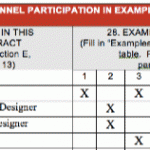
As business developers and marketers, we are on the hook to make sure that the client gets the proposals on time. We know it’s always imperative to get the proposal in under the deadline, but what do you do when it doesn’t get there?
“Why in the world would a proposal not get there?,” you may ask. If you have been in the business long enough, you know that many factors can come into play and result in a problem with your proposal delivery.
Most veterans of the A/E/C business have been in this situation at least once. If you have a solid understanding of this somewhat-taboo subject, you may be able to spin the situation in your favor or, better yet, not get into it in the first place.
Let’s examine why the proposal might not make it to its destination.
Problem: UPS/FEDEX/Delivery services
These services are great, right? They guarantee your package will get there on time or your money back. But what does that mean? Certainly, they will not give you $1 million worth of lost fee if the package doesn’t arrive.
You’ll be lucky if you get your $20 back. And you will spend more than $20 worth of your time trying to do that.
One critical flaw is that these services are run by humans, and “to err is human.” Like any large organization, these services have people who hate their job, who are not above lying, and some that just don’t care. This could mean disaster for your world.
Solutions
Always assume these services will make a mistake. If you give yourself two days for shipping (meaning “gasp” send the proposal a day early), and if you properly track the package, you have time to adjust to their mistakes.
Always call the service to make sure that delivery is guaranteed by a certain time. You’ll be surprised by the places they consider “too remote” to guarantee a delivery time. Also be aware that some procurement officers don’t view your package as received until it is in their hands. So you might want to familiarize yourself with the client’s receiving and mailroom process.
Don’t be afraid to call. If there is a delay with your package, do not take the customer service person’s word. Call the local distribution center responsible for delivering your package. The number can be found online. They have more power to resolve your issue anyway.
If you hire a delivery person to hand deliver the package, make sure you have their number to call them and find out the status of your package delivery. If you are local, it may be a good idea to deliver it yourself and get some “face time” with the client.
Never use hand-written labels. If someone can’t read your writing or it’s too light on their copy, they may just put a bogus address in there and say you gave the wrong address. I have had that happen to me.
Always collect all the evidence. See #4. I was able to get a copy of that label and show the customer service rep that it clearly wasn’t my handwriting.
Always check for addendums to see if there is a change in delivery address.
Problem: You are relying on “last-minute” people
Sure, this is outlandish! Certainly, there are no senior level engineers or architects out there that will wait until the last minute to work on a proposal. And they certainly will not underestimate the time it takes to put everything else together and get it out the door. I don’t know anybody like that and you probably don’t either. But in case you one day meet a person like that:
Solutions
Remember this is your responsibility. If there is anything you can do to work around them, do it. Don’t wait for their piece to do everything else.
Be proactive with help. If you feel confident enough to take a first stab at the technical approach, do it. You probably read a million of these and your best attempt might be equal to their version of “calling it in.” It may be less intimidating for them if they only have to improve upon what you have already done. Just make sure your first draft doesn’t end up in the final proposal.
Be empathetic, often these people are “last minute” because they have too much on their plate. Think in terms of what you can do to help them.
Never be late with your internal deadlines. You must lead the proposal process by example.
Decide on a firm deadline for their section and then move that deadline back a day or two.
Talk in terms of when the proposal is “going out” not when it is “due.”
Never lie about deadlines, but refer to #4 and #5.
Problem: E-mail/Fax
“E-mail me the proposal.” This is music to our ears. No printing, no binding, and no delivery headaches, right? But this is the most common way for the client to not get the proposal. Folks, e-mail today is in a sorry state. Spam, viruses, and other baddies are flooding our e-mail systems. These cause computer networks to slow down, blacklist e-mails, filter out potential questionable e-mails, or try to communicate with your firm’s server (hopefully they speak the same language.)
If any computers in the chain between you and your client are affected by these issues, it may slow down or stop your proposal from getting to its destination.
Solutions
Use a read receipt, if you can. These things work about 55% of the time. Remember, a phone call confirmation is always better.
Send early. Again, always assume that there will be a problem.
Call the client. Make sure it is several hours before the proposal deadline. Usually, if there is a problem they will let you know and you’ll have time to resolve it.
0 is your friend. If you get the client’s voicemail dial this number on your phone. You may be able to get to someone that knows whether your proposal was received.
Problem: Web-based Procurement Portals
Many large private clients rely on procurement portals to receive responses to RFPs. This trend is now growing in the public sector as well. While these systems are less prone to mishaps, they are not perfect.
Solutions
Always carefully read the portal instructions. Usually clients will provide you with detailed instructions on how to use the site. Most of us have been surfing the web so long, that we don’t feel that it is necessary to read the instructions. This is a mistake. Don’t assume the submission is instantaneous. The client may give you until midnight to submit the proposal. That doesn’t mean click the submit button at 11:59pm. Some of these systems convert your submission into an email or post the information to another section of the website and these may not be instantaneous.
Often these services will allow you to review your submission before submitting it. Take this opportunity to do a virtual “flip through” of your proposal, just like you would a hard copy.
Make sure every electronic form is filled out. Before you click submit, many of these services may not have the ability to remind you that you forgot to enter your federal tax ID or Duns number.
If the system does not send you an email or come up with a “thank you for submitting” screen, make sure you call the client to confirm the receipt of your submission.
Problem: All else fails
But if all things fail and your proposal does not make it to the client on time what do you do?
Solutions
Give the client a call as soon as you find out the proposal might not be there on time. Be nice, apologetic and pleasant. Realize that you are still at fault, even though it’s clearly not your fault. Explain the situation, but don’t make it seem like you are giving excuses.
Be empathetic to their situation. They gave you a deadline because someone else gave them a deadline.
Make sure you have documented who you talked to, what happened, and when it’s getting there.
Ask if you can e-mail or fax the package until the original arrives.
Review the RFP. Did they give you the wrong zip code or address? That has happened in the past. Nobody is perfect.
Do not give them anything in writing that says your proposal did not get there in time, unless they specifically ask you for it. And even then, write it like it’s an unfortunate happenstance. Evidence of the incident could spark a legitimate bid protest.
Remember, you did all you could and you have a “leg to stand on.” But that does not mean the client will accept your proposal. But 90% of the time if you follow these best practices, you should be able to correct or avoid the situation.





I’ve heard of A/E/C firms sending their proposals via UPS & FedEx to ensure it gets there and they give the prospective client a heads up too (partly to show how much they want the business and the extra steps they will take, and probably to make sure they aren’t disqualified for submitting to identical proposals.)